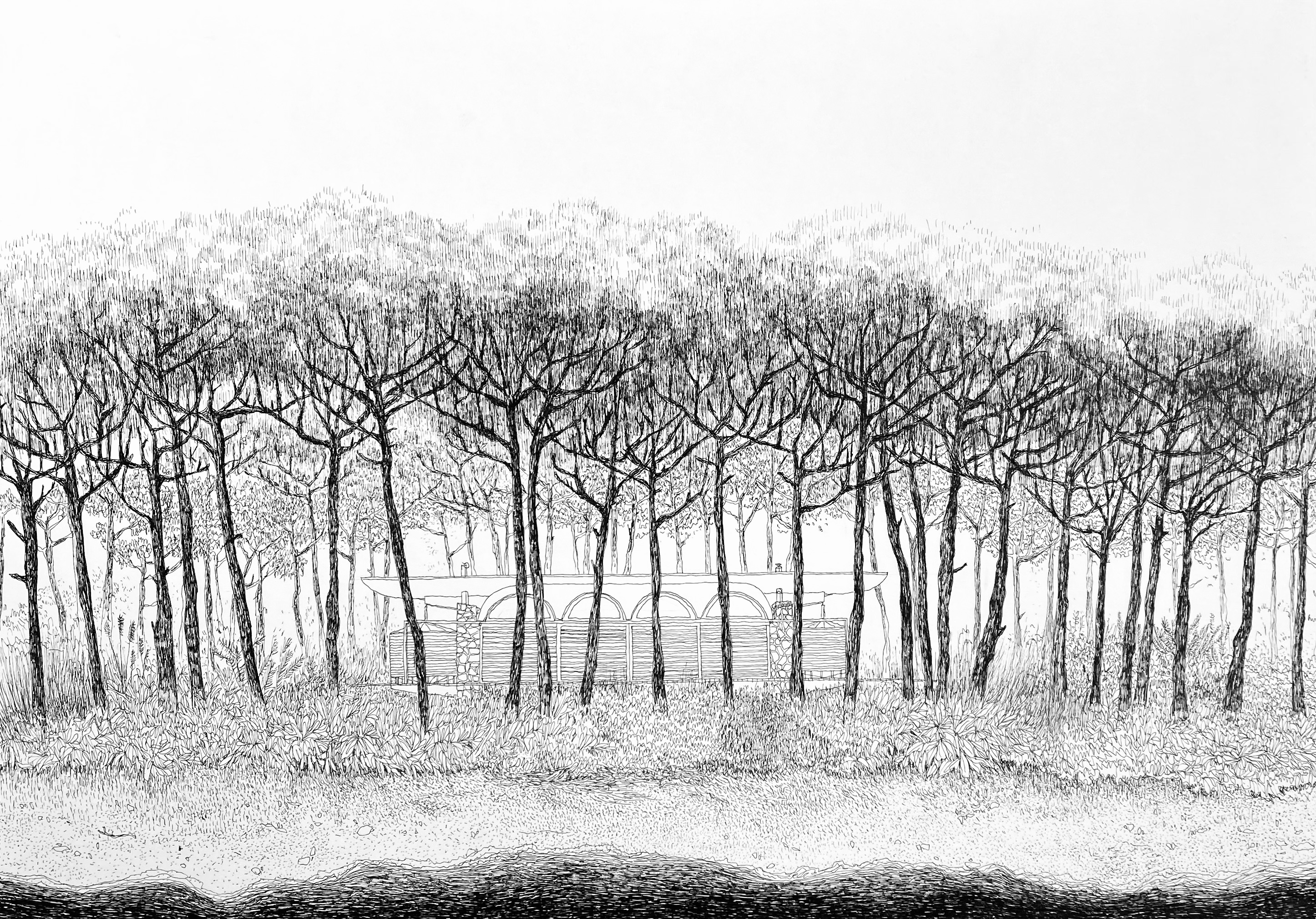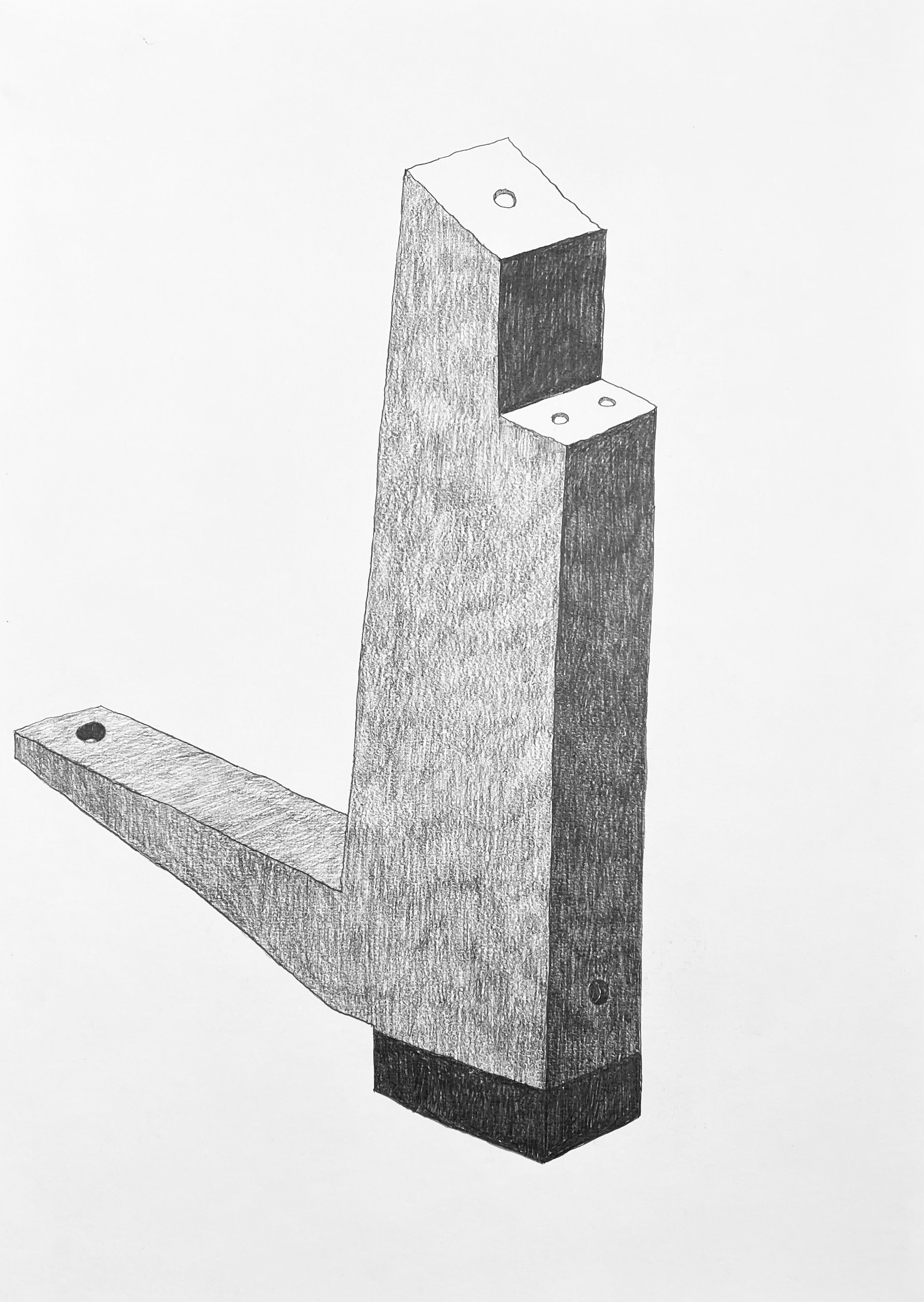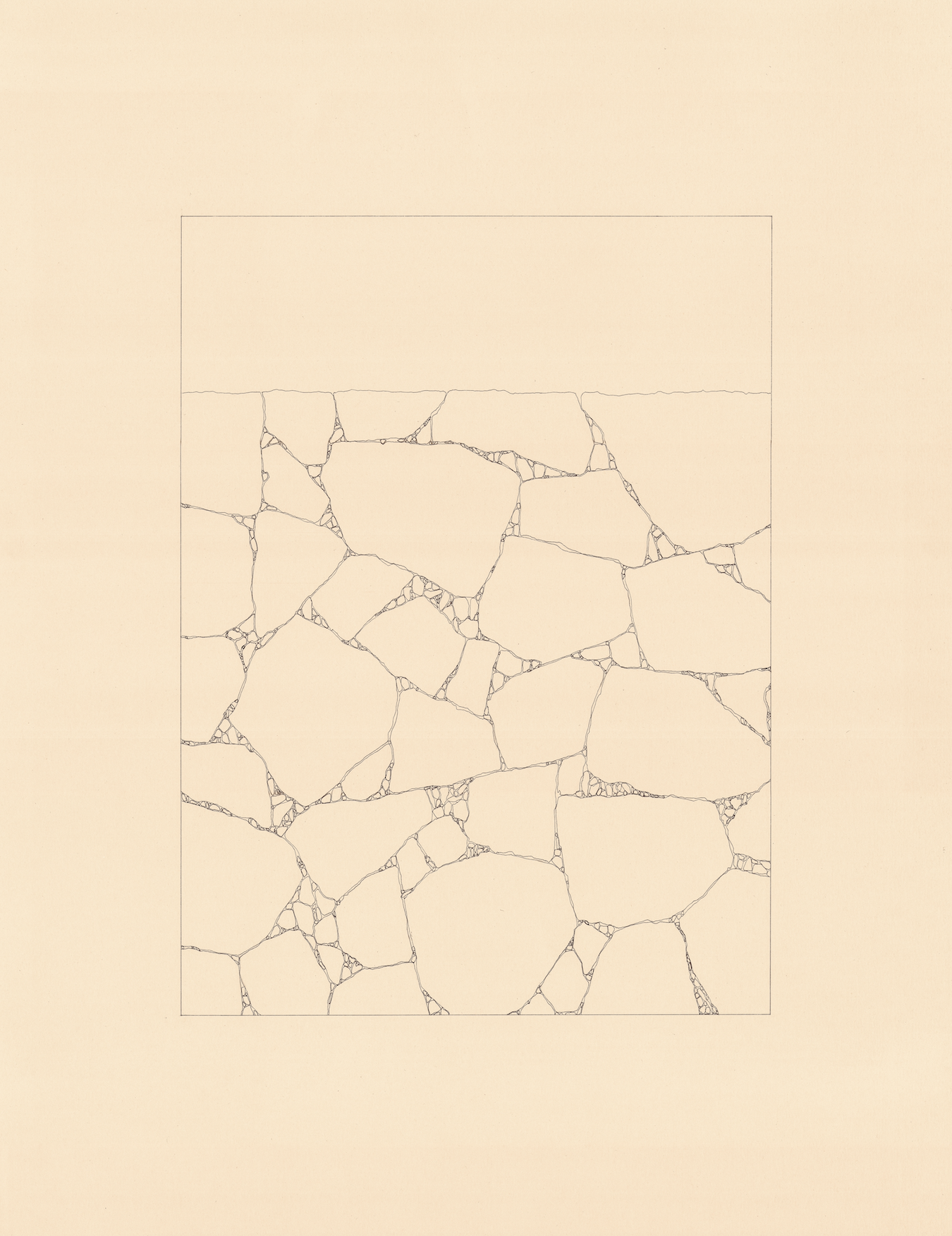Project 02
20 . 02 _ AT _ PORQ

BARBA JUPITER
PISTE DU CAP-MÉDÈS
83420 PORQUEROLLES
Stone walls, a large overhanging roof to shield from the sun, arches to facilitate the flow of air. The archetypes of Mediterranean architecture. This spacious studio is permeated by the site. The exterior and interior blend together to accommodate the work of this painter and provide him with the light he needs.
Like the large canvases of immaculate white, transported by boat, which cross paths with their similarly colored counterparts returning to the mainland; this studio elicits immersion. Here lies the imprint of the site on its canvases turned into artworks.
Barba Jupiter, Anthyllis barba-jovis, or Jupiter's beard, is the name given to a plant endemic to the Mediterranean basin and the island of Porquerolles. It grows amidst the rocks and thrives in very arid conditions, facing the sea's spray. It is one of the terrestrial plants that grow in this final strip before the sea, like a last bastion.
Monsieur T. is a recognized painter, but he describes himself as suffering from a lack of inspiration. His studio employs several people and is quite in line with what one might imagine of an artist's studio in London. A large metal frame recalls the industrial history of the place. The large glass roof illuminates a rectangular space with high white brick walls cluttered with large canvases. Some are finished, others are still in progress. Opposite the entrance, next to the large sink, a window with delicate panes opens onto a small courtyard garden. His only view. To rejuvenate, he makes multiple trips to an island that he holds dear, to rediscover the lights and scents he cherishes.
That island is Porquerolles in the Mediterranean. Mr. T. has roots there and owns an old farmhouse that he has been renovating for years. This imposing building, in the plain of Notre Dame, reflects the island's agricultural past. As far back as the 12th century, citrus fruits, olives, vines, cereals, and medicinal plants were cultivated here. Water was abundant and of high quality, drawn from wells and stored in large cisterns. The island has offered much to those who have inhabited it, but the soda industry in the 19th century permanently altered its resources. Mr. T. is one of those who fiercely defend the natural beauty of this island, with undisguised chauvinism, speaking of it with the tenderness usually reserved for one's own children.
Adjacent to this farmhouse, which stretches over several hectares, is a small plot of land, deemed uninhabitable, facing the sea. Focused on his renovation project, he paid it no attention. But one autumn evening, the idea came to him to set up a second studio there. Mr. T.'s motivations were an invitation to live and paint differently.
The site is magnificent, surrounded by nature, with only pine trees, evergreen oaks, and scrub covering this plot of just over 400m2. Its boundaries are vague, but the path and the beach serve as dividers on either side of the land. A roof of branches and a bed of straw would satisfy anyone.
The challenge of this project was not to appropriate the space in the sense of ownership but to settle temporarily, accepting a transient status. Permanent installation conferred by ownership is not possible here. Modern conveniences are also hindered: running water does not reach here, and electricity would be too costly to install. An island within the island.
It's a place without connections to networks, without beware-of-dog signs, and above all, without property boundaries. There's nothing to steal, nothing to take, nothing to claim. Only a shelter with a floor and a roof to occasionally occupy this natural site.
Mr. T. will live on this site for a few months each year and can enhance this comfort with a mattress, linens, kitchen utensils, and painting supplies. Water, collected in two immense stainless steel tanks, will be the rain that falls from the sky. It will be used for washing, cleaning, and watering the garden. A small reservoir of drinking water, housed in one of the two tanks, replenished by pickup, can last for a few weeks. As for electricity, it is provided by a small domestic wind turbine, supplemented by solar panels. The small storage battery can last for 2 days without wind or sun.
This autonomy is made possible by normal weather conditions recorded on the site. But water, abundant in the fall and winter, can carry through the spring and early summer. The tourist season makes the studio uninhabitable, and droughts dry up the tanks until early autumn.
When you grasp this dimension, it is possible to build with heavy materials, moreover, extracted from the site. It's neither a cabin nor a shelter. It's a studio for a painter.
That island is Porquerolles in the Mediterranean. Mr. T. has roots there and owns an old farmhouse that he has been renovating for years. This imposing building, in the plain of Notre Dame, reflects the island's agricultural past. As far back as the 12th century, citrus fruits, olives, vines, cereals, and medicinal plants were cultivated here. Water was abundant and of high quality, drawn from wells and stored in large cisterns. The island has offered much to those who have inhabited it, but the soda industry in the 19th century permanently altered its resources. Mr. T. is one of those who fiercely defend the natural beauty of this island, with undisguised chauvinism, speaking of it with the tenderness usually reserved for one's own children.
Adjacent to this farmhouse, which stretches over several hectares, is a small plot of land, deemed uninhabitable, facing the sea. Focused on his renovation project, he paid it no attention. But one autumn evening, the idea came to him to set up a second studio there. Mr. T.'s motivations were an invitation to live and paint differently.
The site is magnificent, surrounded by nature, with only pine trees, evergreen oaks, and scrub covering this plot of just over 400m2. Its boundaries are vague, but the path and the beach serve as dividers on either side of the land. A roof of branches and a bed of straw would satisfy anyone.
The challenge of this project was not to appropriate the space in the sense of ownership but to settle temporarily, accepting a transient status. Permanent installation conferred by ownership is not possible here. Modern conveniences are also hindered: running water does not reach here, and electricity would be too costly to install. An island within the island.
It's a place without connections to networks, without beware-of-dog signs, and above all, without property boundaries. There's nothing to steal, nothing to take, nothing to claim. Only a shelter with a floor and a roof to occasionally occupy this natural site.
Mr. T. will live on this site for a few months each year and can enhance this comfort with a mattress, linens, kitchen utensils, and painting supplies. Water, collected in two immense stainless steel tanks, will be the rain that falls from the sky. It will be used for washing, cleaning, and watering the garden. A small reservoir of drinking water, housed in one of the two tanks, replenished by pickup, can last for a few weeks. As for electricity, it is provided by a small domestic wind turbine, supplemented by solar panels. The small storage battery can last for 2 days without wind or sun.
This autonomy is made possible by normal weather conditions recorded on the site. But water, abundant in the fall and winter, can carry through the spring and early summer. The tourist season makes the studio uninhabitable, and droughts dry up the tanks until early autumn.
When you grasp this dimension, it is possible to build with heavy materials, moreover, extracted from the site. It's neither a cabin nor a shelter. It's a studio for a painter.
Self-sufficient studio
and dwelling
Start date: 2020
Area: 970 sq. ft
and dwelling
Start date: 2020
Area: 970 sq. ft
New construction
Interior and furniture project
Power generation unit with a domestic wind turbine and solar panels
Two EP recovery tanks and a drinking water tank Concrete pile foundation
Precast concrete pier and beamstone wall
Wooden floor
Concrete frame
Precast concrete shell cover
Welded stainless steel tank
Materials inventory:
Island crushed stone and rock block + Precast concrete + Rammed earth + Pine wood + Cork oak insulation panels + Pine wood exterior joinery + Clay tiles + Pine wood deck
Interior and furniture project
Power generation unit with a domestic wind turbine and solar panels
Two EP recovery tanks and a drinking water tank Concrete pile foundation
Precast concrete pier and beamstone wall
Wooden floor
Concrete frame
Precast concrete shell cover
Welded stainless steel tank
Materials inventory:
Island crushed stone and rock block + Precast concrete + Rammed earth + Pine wood + Cork oak insulation panels + Pine wood exterior joinery + Clay tiles + Pine wood deck








































